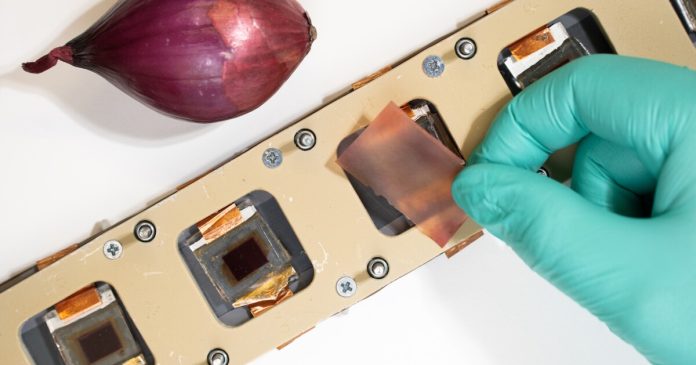Solar cells are subjected to a lot of harmful ultraviolet light, as they’re typically placed for maximum sunlight exposure. A new eco-friendly coating could help protect them from those UV rays, and its active ingredient is extracted from onion skin.
Currently, clear films made of petroleum-based materials are applied to the surface of solar cells for UV protection. Both the acquisition and the processing of the petroleum aren’t environmentally-friendly procedures, nor is the disposal of the film-coated cells once they’ve reached their end of use.
For this reason, scientists have been looking into bio-based alternatives to the petroleum-based films. One promising candidate is a material known as nanocellulose, which is composed of tiny cellulose fibers obtained from plant sources such as agricultural or forestry waste.
It can’t do the job all on its own, however.
With that fact in mind, Finnish and Dutch scientists recently experimented with three different additives: cross-linked iron ions, nanoparticles of a plant-based biopolymer known as lignin, and an anthocyanin dye extract obtained from red onion skin. Previous research showed that all of these substances have UV-blocking properties.
Väinö Anttalainen
In lab tests, separate sheets of nanocellulose film that had been treated with each of the additives were applied to dye-sensitized solar cells, which were then placed under a UV lamp for 1,000 hours. This was reportedly equivalent to roughly a year of open-air sunlight exposure in a central European climate.
It was found that the onion-dye film performed best, blocking 99.9% of UV light with a wavelength of up to 400 nanometers. That said, it still allowed over 80% of visible light transmission at longer wavelengths, and continued to do so throughout the testing period. Visible light is what solar cells use to generate electricity.
Importantly, these figures were actually higher than those reported for commonly-used PET (polyethylene terephthalate) petroleum-based UV-blocking film.
It is hoped that the onion-dye nanocellulose film could one day be used not only on conventional solar cells, but particularly on ones designed to be completely biodegradable, such as those that power remotely-located environmental sensors.
The study was conducted by scientists from the University of Turku and Aalto University in Finland, and Wageningen University in the Netherlands. It is described in a paper that was recently published in the journal ACS Applied Optical Materials.




